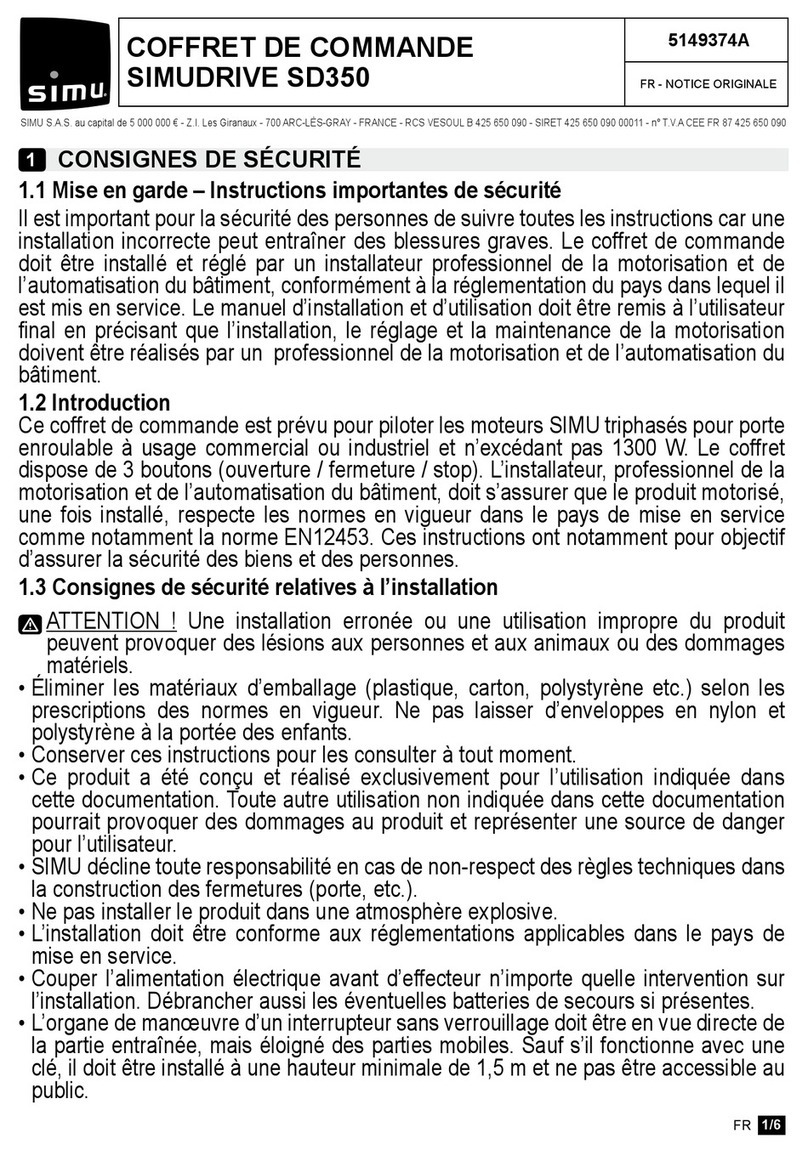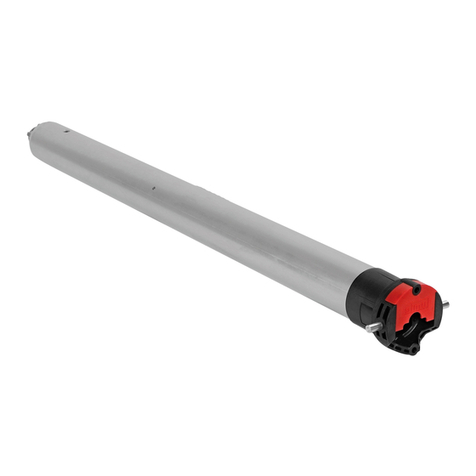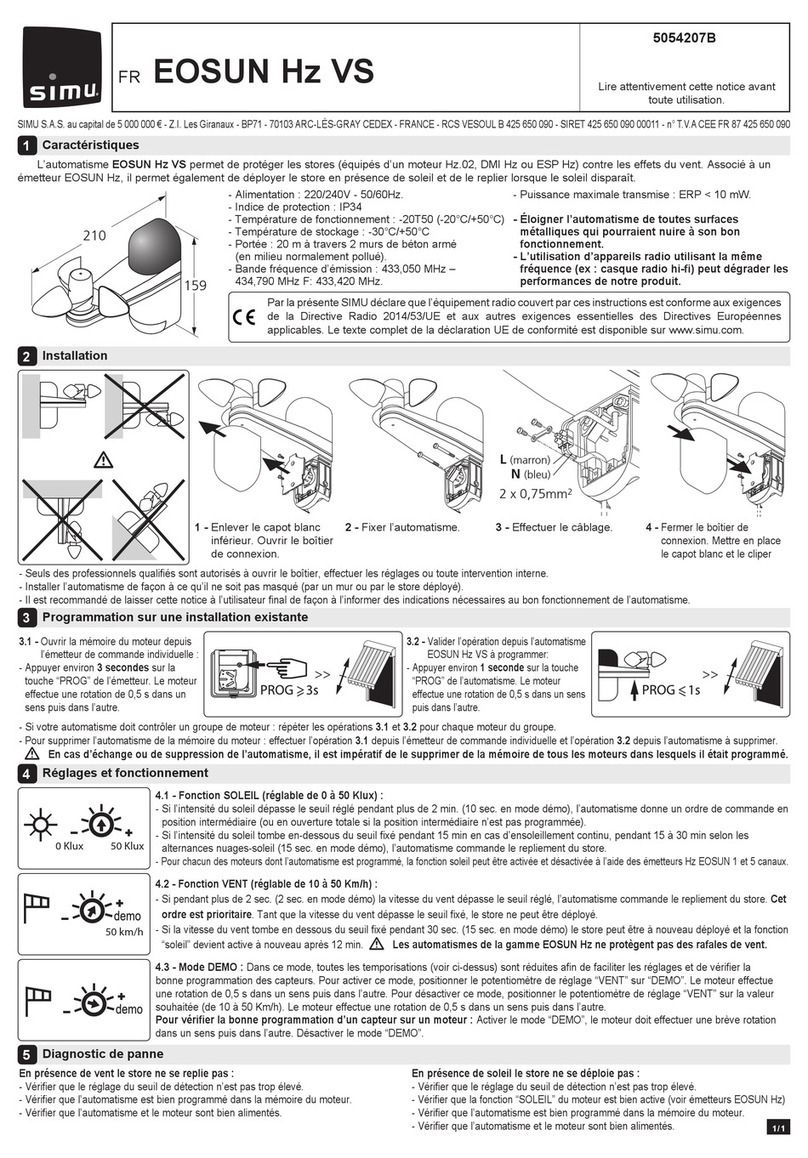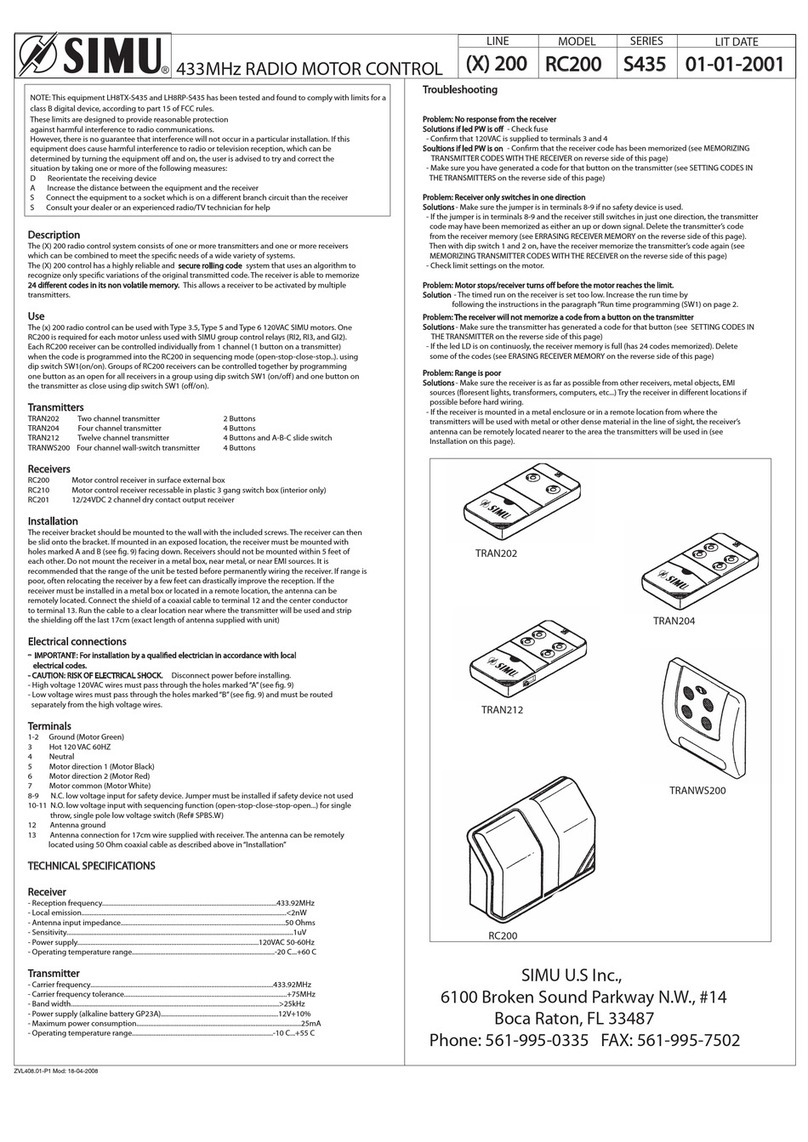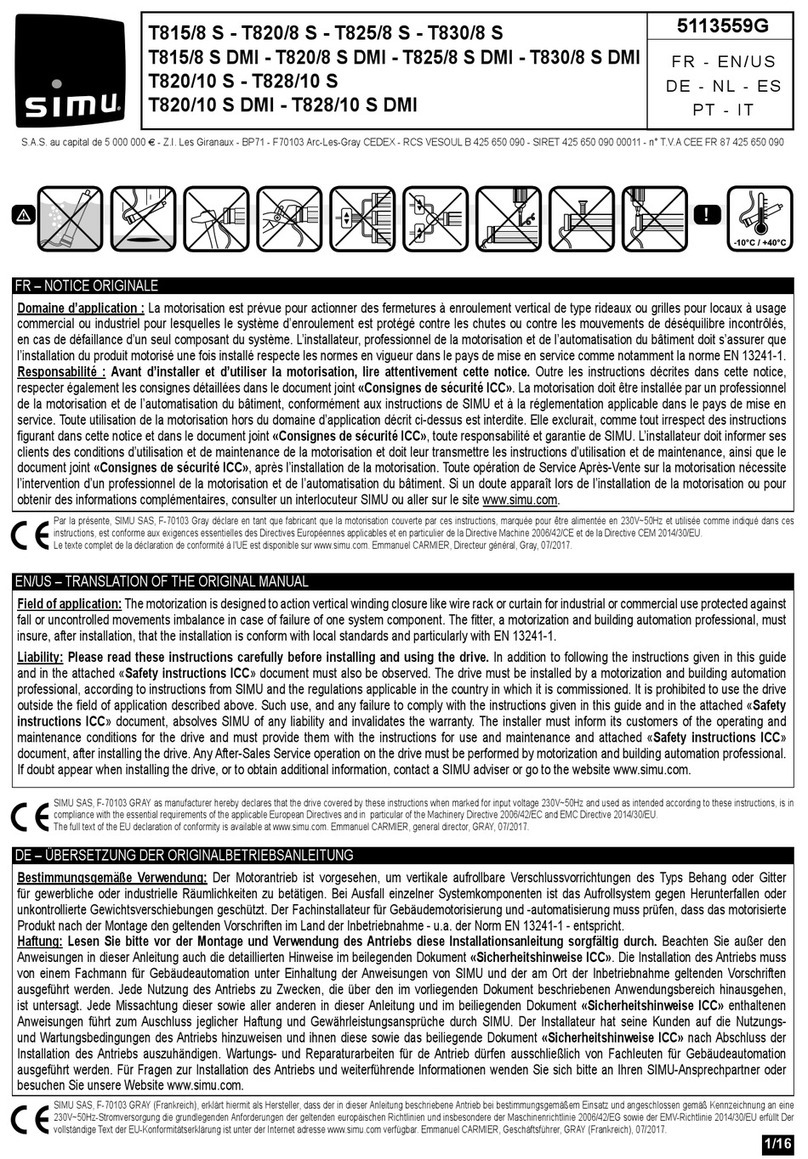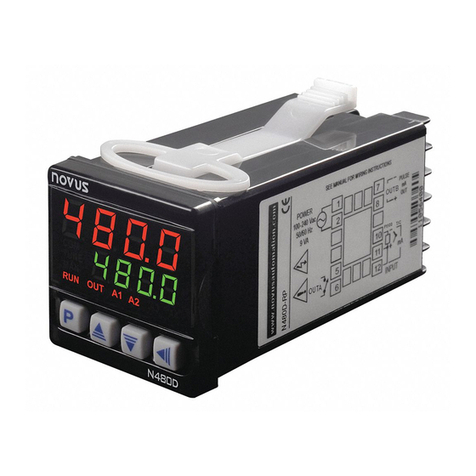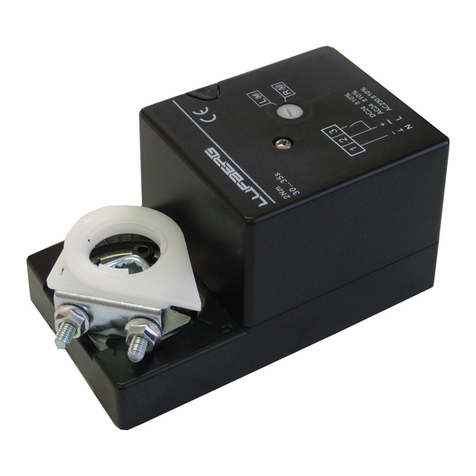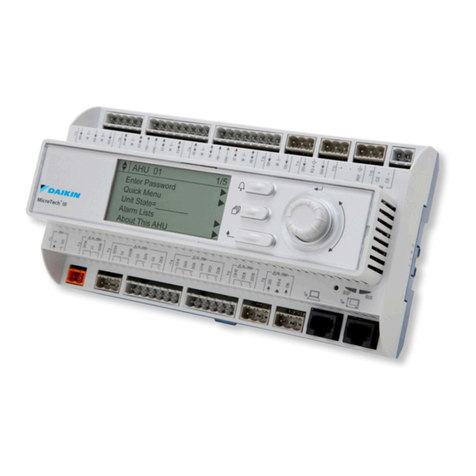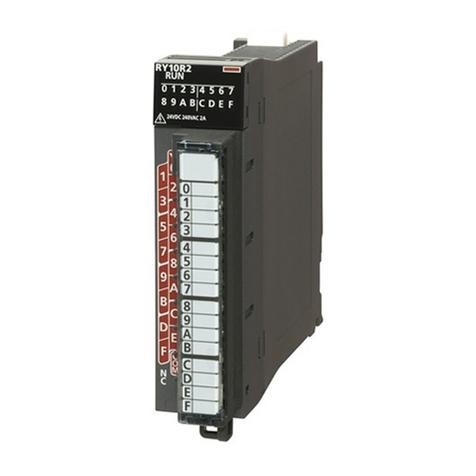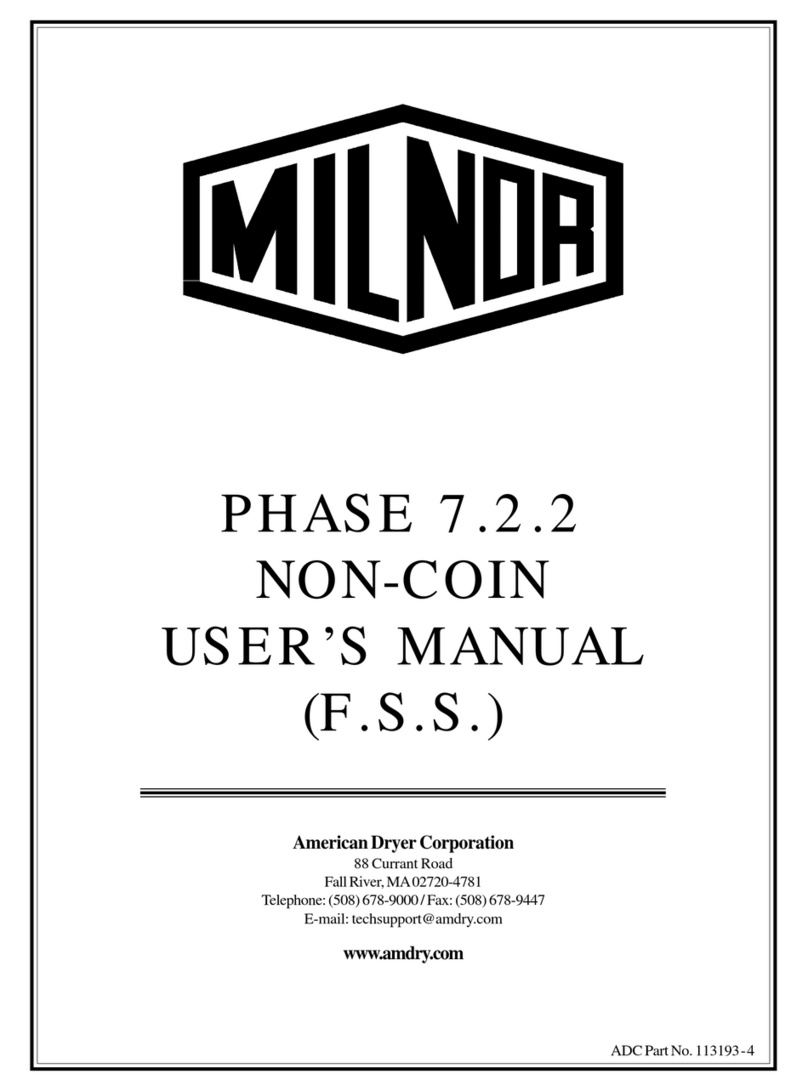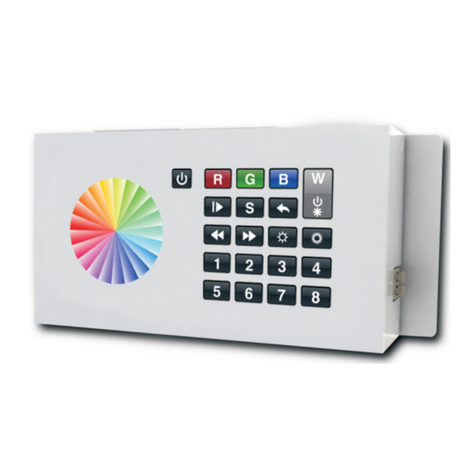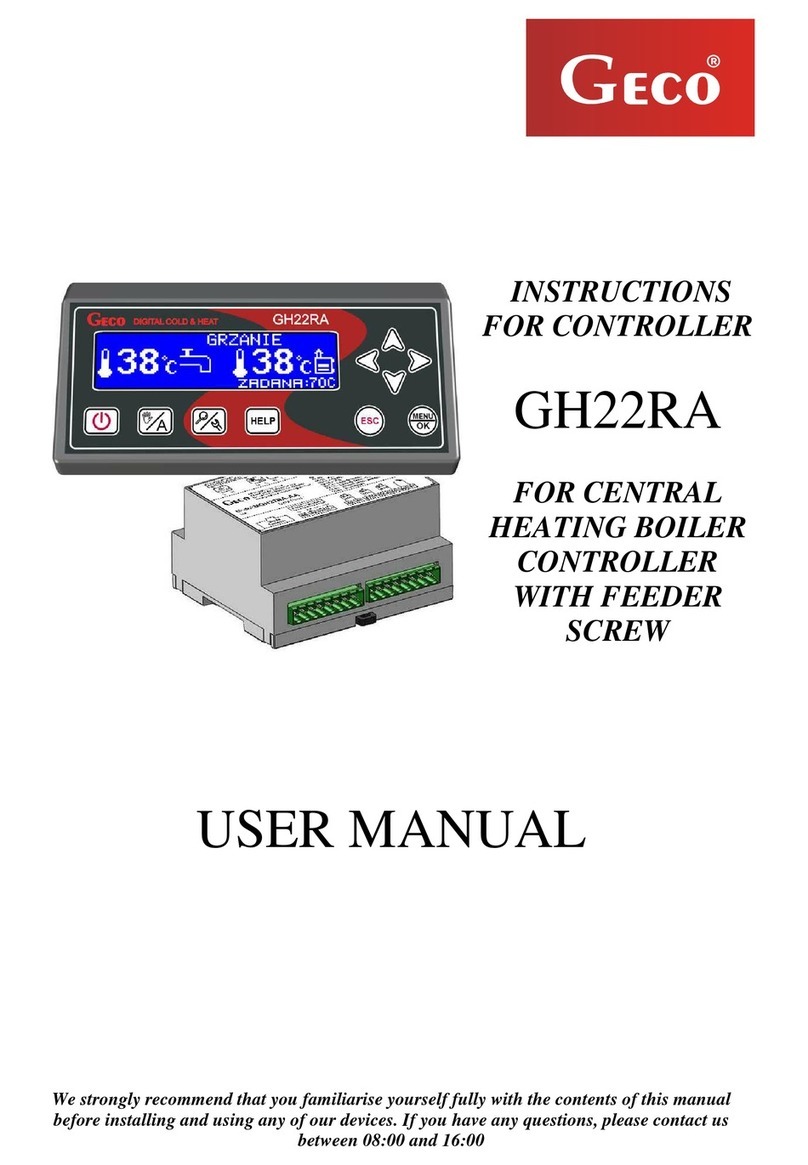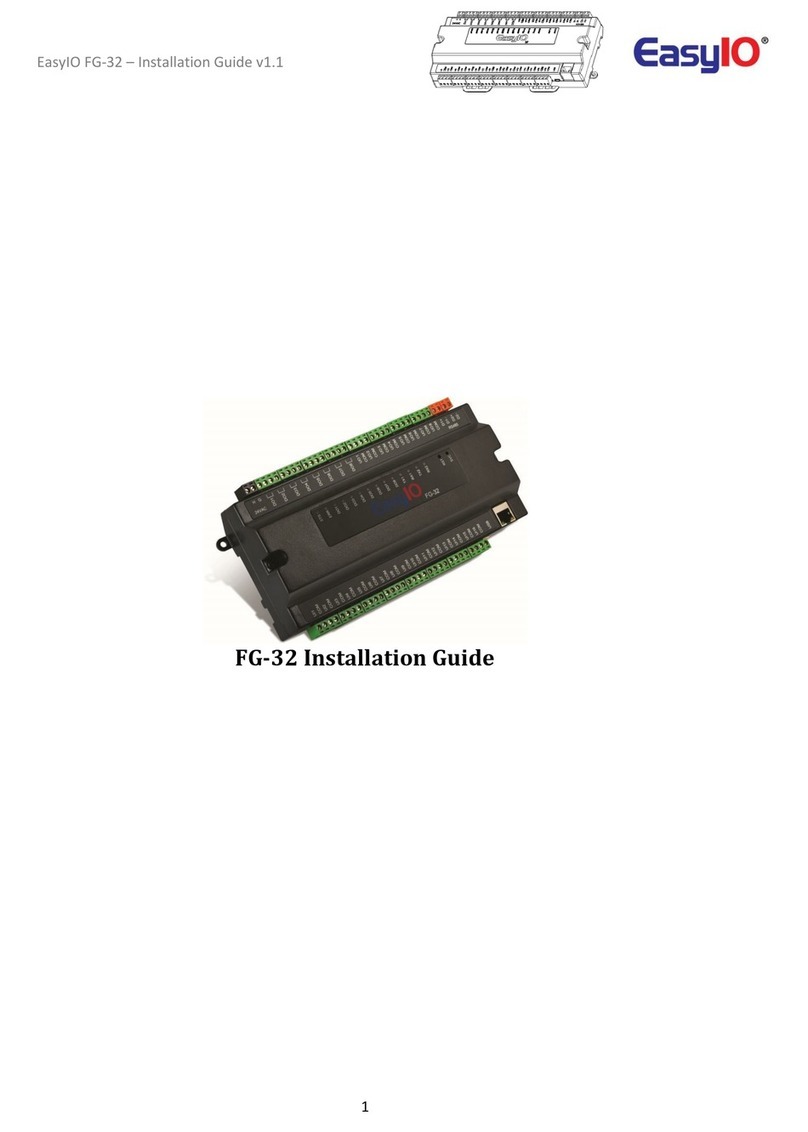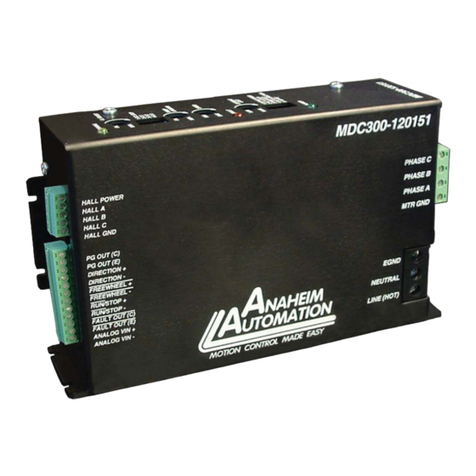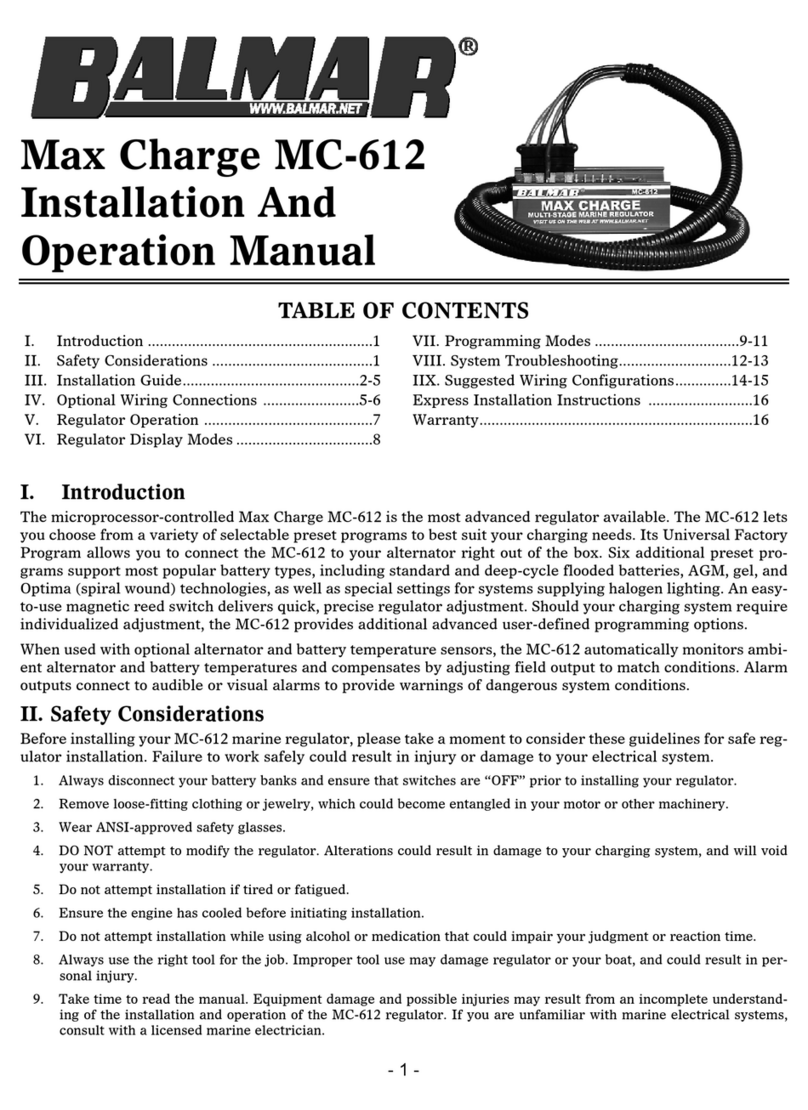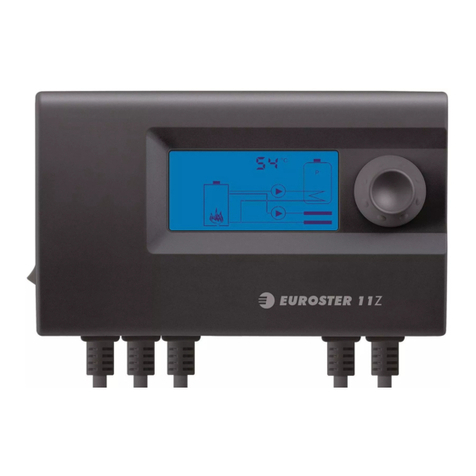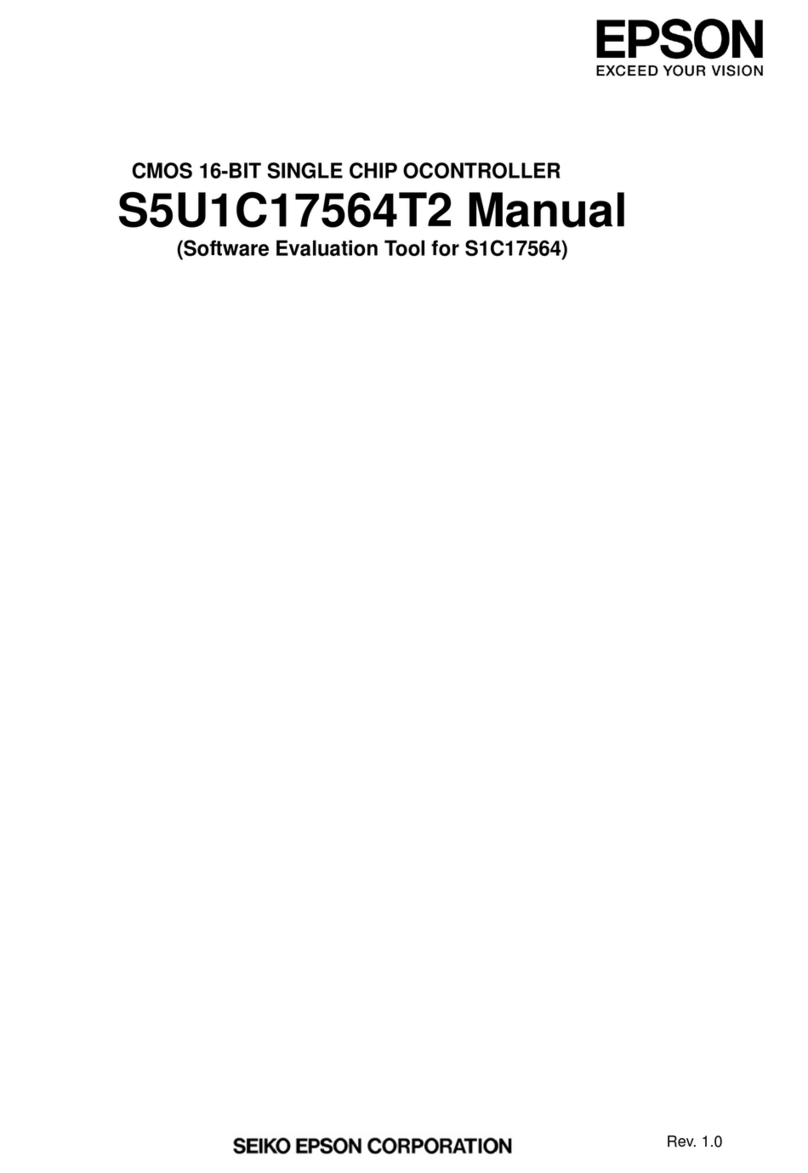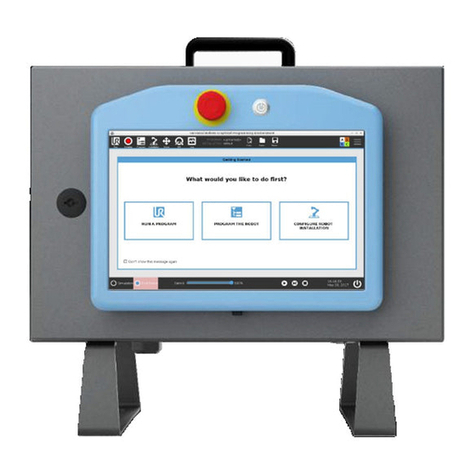Simu SIMUDRIVE 410 User manual

FR COFFRET DE COMMANDE SIMUDRIVE 410
S.A.S. au capital de 5 000 000 €- Z.I. Les Giranaux - BP71 - F70103 Arc-Les-Gray CEDEX - FRANCE - RCS VESOUL B 425 650 090 - SIRET 425 650 090 00011 - n° T.V.ACEE FR 87 425 650 090
5014016E
Lire attentivement cette notice avant
toute utilisation.
Caractéristiques techniques
1
Généralités
2
Cette motorisation est conforme à la norme « Sécurité, règles particulières pour les motorisations de portails et portes » (norme EN 60335-
2-103:2004). Ce produit, installé selon les présentes instructions, permet une mise en place conforme aux normes EN 13241-1:2003 et
EN 12453:2001. Les instructions, citées dans les notices d’installation et d’utilisation de ce produit, ont pour objectif de satisfaire les exigences
de sécurité des biens, des personnes et des dites normes. Dans le cas de non-respect de ces instructions, SIMU se libère de toute responsa-
bilité des dommages qui peuvent être engendrés.
- Alimentation triphasée 400V avec neutre ou monophasé 230V.
- Courant de sortie du moteur : I max. Tri. : 3A - I max. Mono. : 5,6A
- Courant de commande du moteur : 8A / 12A
- Puissance max. du moteur : Pmax. Tri. 1270W / Pmax. Mono. 1200W
- Protection par fusibles : 10A
- Alimentation des accessoires : 24Vac 0,5A
- Sortie pour feu orange clignotant et/ou feu fixe : 230Vac - 200W
- Température de fonctionnement : -10° à + 50°C (-10T50)
- Indice de protection : IP55
- Dimensions : 340 x 220 x 130 mm
- Poids : 2.9 Kg
Le coffret de commande peut piloter un moteur monophasé ou triphasé pour porte enroulable. Il dispose de deux boutons poussoirs
(ouverture/femeture). Une série de leds permet de vérifier ou de localiser les anomalies de fonctionnement de l’unité de commande ou des
dispositifs annexes. L’unité de commande est dotée de micro-switches et de potentiomètres qui en permettent la configuration et le réglage.
Auto-test : l’unité de commande permet d’effectuer le contrôle des relais de marche et des dispositifs de sécurité (cellules photoélectriques,
barre palpeuse, etc.), avant d’effectuer chaque manoeuvre.
ATTENTION! Une installation erronée ou une utilisation impropre du produit peuvent provoquer des lésions aux personnes et aux
animaux ou des dommages matériel.
- Eliminer les matériaux d’emballage (plastique, carton, polystyrène etc.) selon les prescriptions des normes en vigueur. Ne pas laisser d’en-
veloppes en nylon et polystyrène à la portée des enfants.
- Conserver les instructions pour les consulter à tout moment.
- Ce produit a été conçu et réalisé exclusivement pour l’utilisation indiquée dans cette documentation. Toutes autres utilisations non indi-
quées dans cette documentation pourraient provoquer des dommages au produit et représenter une source de danger pour l’utilisateur.
- SIMU décline toute responsabilité dérivée d’une utilisation impropre ou différente de celle à laquelle le produit a été destiné et qui est indi-
quée dans cette documentation.
- Ne pas installer le produit dans une atmosphère explosive.
- SIMU décline toute responsabilité en cas de non respect des règles technique dans la construction des fermetures (portes, etc.).
- L’installation doit être conforme aux prescriptions des Directives Européennes: 89/336/CEE, 73/23/CEE, 98/37/CEE et modifications suc-
cessives.
- Couper l’alimentation électrique avant d’effectuer n’importe quelle intervention sur l’installation. Débrancher aussi les éventuelles batteries
de secours, si présentes.
- Pour l’ alimentation de la motorisation, prévoir un interrupteur omnipolaire avec distance d’ouverture des contacts égale ou supérieure à
3mm.
- L’ alimentation doit présenter en amont un interrupteur différentiel avec seuil de 0,03A.
- Vérifier si l’installation de terre est effectuée correctement: connecter toutes les parties métalliques de la fermeture (portes, etc.) et tous les
composants de la motorisation dotés de borne de terre.
- SIMU décline toute responsabilité en matière de sécurité et de bon fonctionnement de la motorisation si des composants d’autres fournis-
seurs sont utilisés.
- Utiliser exclusivement des pièces originales pour tout entretien ou réparation.
- Ne pas effectuer de modifications aux composants de la motorisation.
- Informer l’utilisateur de l’installation sur les systèmes de commande appliqués et sur l’exécution de l’ouverture manuelle en cas d’urgence.
- Ne pas permettre à des personnes et à des enfants de stationner dans la zone d’action de la motorisation.
- Ne pas laisser de télécommandes ou d’autres dispositifs de commande à portée des enfants afin d’éviter des actionnements involontaires
de la motorisation.
- L’utilisateur doit éviter toute tentative d’intervention ou de réparation de la motorisation et ne doit s’adresser qu’à du personnel qualifié.
- Tout ce qui n’est pas expressément prévu dans ces instructions est interdit. 1/8

41
JP5
40 39 38 37
DL1
L1
L2
L3
N
Vérifier sur JP5 que le pont
se trouve entre 39 et 40
41
JP5
40 39 38 37
DL1
Vérifier sur JP5 que le pont
se trouve entre 40 et 41
L
N
2/8
Câblage
3
3.1 - Possibilités de câblage :
3.2 - Alimentation du boîtier (le boîtier est fourni en configuration triphasé 400V)
MONOPHASE 230V - 50Hz TRIPHASE 400V - 50Hz + NEUTRE
ATTENTION :
- Pour les opérations de câblage et d’installation, se référer aux normes en vigueur et en tous les cas aux principes de bonne technique.
- Les conducteurs alimentés avec des tensions différentes doivent être physiquement séparés ou isolés avec une isolation supplémentaire
d’au moins 1mm.
- Les conducteurs doivent être fixés par une fixation supplémentaire à proximité des bornes, par exemple avec des colliers.
- Pour la connexion au réseau électrique, utiliser un câble multipolaire de section minimale 3x1.5mm2et du type prévu par les normes en
vigueur. Atitre d’exemple, si le cable est à l’exterieur (exposé aux intempéries), il doit au moins être égal à H07RN-F tandis qu’à l’interieur
ou bien à l’exterieur dans un canal de protection, il doit au moins être égal à H05 VV-F avec 3x1.5mm2de section.
NOTA : Avant de connecter l’unité de commande au réseau électrique, s’assurer que la borne JP5 (changement de tension) est prédisposée
pour la bonne tension de travail. La carte est fournie avec une série de bornes connectées en fils volants. Les ponts concernent les
bornes : 26-30, 26-31.

26 27 28 29 30 31 32 33 34 35 36
Vérifier la présence de ponts entre :
26 et 30
26 et 31
5 : sens 1 - 6 : neutre - 7 : sens 2
1 2 3 4 5 6 7 8 9
JP1
JP4
La terre doit être raccordée
S1 N S2
2 1 3
VERT / JAUNE
230V-50Hz
BLEU
MARRON
NOIR
PE
N
L
ANTICHUTE
1
2
3
26 27 28 29 30 31 32 33 34 35 36
Supprimer les ponts entre 26 et 30,
26 et 31 et remplacer par :
5 : phase 1
6 : phase 2
7 : phase 3
26 - 30 : fin de course sens 1 (contact NF)
26 - 31 : fin de course sens 2 (contact NF)
1234567
M1 M2 M3
8 9
JP1 JP4
La terre doit être raccordée
UVW XYZ 12 34 56
ANTICHUTE
3/8
3.3 - Connection d'un moteur
MOTEUR MONOPHASE
230V - 50Hz
MOTEUR TRIPHASE
400V - 50Hz
Sur le moteur T8, la manœuvre de dépannage doit être en série sur le commun (N)
3.4 - Alimentation des accessoires de sécurité :
Alimentation d’un barrage cellules SIMUAlimentation de la barre palpeuse SIMU
Si mode " appui maintenu ", passez directement au chapitre 3.7

4/8
3.5 - Câblage des accessoires de sécurité (pour une meilleure lisibilité des schémas, l’alimentation n’est pas représentée, voir §3.4) :
Câblage barre palpeuse + 1 barrage cellules
Câblage barre palpeuse + 2 barrages cellules
Câblage barre palpeuse + 3 barrages cellules
Câblage barre palpeuse + 4 barrages cellules
Câblage du feu clignotant et de l’éclairage de zone

5/8
3.6 - Connection des organes de commande :
3.6.1 - Commandes filaires (les deux boutons poussoir en façade sont pré-câblés : 26 : commun, 33 : ouverture, 34 : fermeture) :
- Exemple de câblage avec boîte à clé impulsionnelle (2004964) :
- Exemple de câblage avec boîte 3 boutons (1850046) :
26 - 27 = Start (NO)
26 - 28 = Stop (NF)
26 - 33 = Ouverture (NO)
26 - 34 = Fermeture (NO)
3.6.2 - Commande radio :
11 et 12 = alimentation 24Vac
26 = commun
27 = Start
26 27 28 29 30 31 32 33 34 35 36
INVERSEUR A CLE UNIVERSEL INVERSEUR ROTATIF INSTABLE
M
N1 N2
M
M
N1N2P 1 JP4
N1
Test du sens de rotation
OK
JP1
567
S1 N S2
JP1
5 6 7
M1 M2 M3
MOTEUR MONOPHASE
230V - 50Hz
MOTEUR TRIPHASE
400V - 50Hz

6/8
3.7.2 - Mise en place des ponts :
3.7.3 - Programmation des contacts :
3.7.4 - Test du sens :
Installer des ponts entre 26 et 29
et entre 26 et 35
Attention, aucune modification ne doit être apportées à la programmation par défaut des micro-contact.
26 27 28 29 30 31 32 33 34 35 36
Vérifier la présence de ponts entre :
26 et 29
26 et 35
VERT / JAUNE
230V-50Hz
BLEU
MARRON
NOIR
PE
N
L
ANTICHUTE
1
ON
2345678910
Toutes modifications de programmation rendront l'installation non-conforme.
26 27 28 29 30 31 32 33 34 35 36
INVERSEUR ROTATIF INSTABLE
M
N1 N2
M
M
N1N2
JP4
3.7 - Câblage en mode " appui maintenu "
3.7.1 - Câblage avec inverseur rotatif instable (ou boîte à clé instable) (2001548) (2006754) :
OK
JP1
567
S1 N S2
JP1
5 6 7
M1 M2 M3
MOTEUR MONOPHASE
230V - 50Hz
MOTEUR TRIPHASE
400V - 50Hz

1
ON
2345678910
7/8
4.1 - Programmation des micro-contacts
Programmation
4
1 et 2 : Cellules photoélectriques (FCH)
ON - Exclut le fonctionnement de la cellule photoélectrique en ouverture et inverse immédiatement en phase de fermeture en cas d’occultation de la cellule
photoélectrique.
OFF - Si un obstacle occulte la cellule photoélectrique lorsque la porte est en fermeture, celle-ci s’arrête; une fois l’obstacle éliminé, la porte s’ouvre à nouveau.
Si un obstacle occulte la cellule photoélectrique lorsque la porte est en ouverture, celle-ci s’arrête; une fois l’obstacle éliminé, la porte continue l’ouverture
(avec installation de sécurité haute).
3 : Blocage des impulsions (IBL)
ON - L’impulsion de start n’a aucun effet dans la phase d’ouverture.
OFF - L’impulsion de start pendant la phase d’ouverture provoque l’arrêt de la porte.
4 : Fermeture automatique (TCA)
ON - Effectue la fermeture automatique de la porte après un temps de pause introduit par le potentiomètre TCA (§4.2). La fermeture automatique est activée
par l’arrivée de la porte en position de fin de course d’ouverture, par la fin du temps de travail dans la phase d’ouverture ou par l’arrêt de la porte dans la
phase d’ouverture au moyen de l’impulsion de start.
OFF - Exclut la fermeture automatique.
5 : Logique à 2 ou 4 pas (2P/4P)
ON - Une impulsion de start donnée pendant que la porte est en fermeture provoque l’inversion de la direction de marche, en ouverture elle en provoque l’arrêt
(contact 3 sur OFF).
OFF - Une impulsion de start donnée pendant que la porte est en mouvement provoque l’arrêt; l’impulsion suivante provoque l’inversion de la direction de
marche (logique 4 pas).
N.B.: L’impulsion de start dans la phase d’ouverture n’a aucun effet avec le contact 3 sur ON.
6 : Préalarme (PREALL)
ON - La sortie auxilliaire 230Vac s’active environ 3 secondes avant le démarrage du moteur.
OFF - La sortie auxilliaire 230Vac s’active en même temps que le démarrage des moteurs.
7 : Commande Ouvre/Ferme (U.P.)
Agit sur les signaux connectés aux bornes 33-34.
ON - Fonctionnement à action maintenue: la manoeuvre continue tant que le bouton de commande reste enfoncé.
OFF - Fonctionnement Ouverture/Fermeture séparé automatique : avec une impulsion, la porte s’ouvre si elle fermée et vice versa.
8 : Echelle des temps de travail réduite ou normale (S.TW)
ON - Temps de travail TW compris dans l’intervalle 1 - 90 secondes.
OFF - Temps de travail TW compris dans l’intervalle 3 - 210 secondes.
9 : Cellules photoélectriques non testées (FNV)
Agit sur la logique de contrôle des cellules photoélectriques.
ON - Les cellules photoélectriques sont exclues du cycle de vérification des sécurités effectué avant chaque manoeuvre; l’état logique est en tous les cas utilisé
(se référer comme connexion à la typique façon de connecter les cellules photoélectriques, soit avec faisceau toujours actif).
Utilisé pour connecter des cellules photoélectriques non testées ou bien avec autodiagnostic interne et fournissant en tous les cas un contact libre de tension.
OFF - Les cellules photoélectriques sont insérées dans le cycle de vérification des sécurités effectué avant chaque manoeuvre.
Pour la connexion, se référer aux schémas joints.
10 : Barre palpeuse non testée (BAR)
Agit sur la logique de contrôle du dispositif barre palpeuse.
ON - Les dispositifs barre palpeuse sont exclus du cycle de vérification des sécurités effectué avant chaque manoeuvre. Utilisé pour connecter des barres
palpeuses non vérifiées ou bien avec autodiagnostic interne et fournissant en tous les cas un contact libre de tension.
OFF - Les dispositifs barre palpeuse sont insérées dans le cycle de vérification des sécurités effectué avant chaque manoeuvre. Pour la connexion, se référer
aux schémas joints.
1 - FCH
2 - FCH
3 - IBL
4 - TCA
5 - 2P / 4P
6 - PREALL
7 - U.P.
8 - S.TW
9 - FNV
10 - BAR
COUPER L’ALIMENTATION APRES CHAQUE CHANGEMENT
DE PROGRAMMATION AFIN DE MEMORISER CELLE-CI.

8/8
1 2 3 4 5 6 7 8 9
JP6
JP2
JP1
JP7
JP4
R31 R32 R33
DL2
DL1
DL14
DL3 DL4 DL5 DL6 DL7 DL8
1
ON
2345678910
DL9 DL10 DL11 DL12 DL13
TWPED TCA TW
10 11 12 13 14 15
252423222120
16 17 18 19
26 27 28 29 30 31 32 33 34 35 36
4.2 - Réglage des temps de fonctionnement
4.3 - Fonction des LEDS
TW.PED : Non utilisé dans le cadre de cette application.
TW : Règle le temps de fonctionnement tant en ouverture qu’en
fermeture.
TCA : Règle le temps de pause après lequel la porte se referme
automatiquement (réglable de 1 à 120 secondes).
Le boîtier de commande SIMUDRIVE 410 est dotée d’une série de led utiles pour l’identification d’éventuelles anomalies de l’installation.
■
DL1 : Reste allumée en présence de courant et avec fusible F1 intact.
■
DL2 : S’allume lorsque le moteur est activé en fermeture.
■
DL3 : S’allume lorsque le moteur est activé en ouverture.
■
DL4 : S’allume à la commande de start (bornes 26 - 27).
■
DL5 : S’allume à la commande de blocage (stop par bouton poussoir ou moteur en sonde thermique - bornes 26 - 28).
■
DL6 : S’éteint avec les cellules photoélectriques non alignées ou en présence d’obstacles. Avec le contact 9 sur OFF, les cellules photoé-
lectriques et la led correspondante ne sont activées que pendant la manoeuvre (bornes 26 - 29).
■
DL7 : S’éteint avec la porte en position d’ouverture complète, si dotée de fin de course (bornes 26 - 30).
■
DL8 : S’éteint avec la porte en position de fermeture complète, si dotée de fin de course (bornes 26 - 31).
■
DL9 : Non utilisé dans le cadre de cette application.
■
DL10 : S’allume à la commande manuelle d’ouverture (bornes 26 - 33).
■
DL11 : S’allume à la commande manuelle de fermeture (bornes 26 - 34).
■
DL12 : S’éteint lors de l’intervention de la barre palpeuse. Avec le contact 10 sur OFF, la barre palpeuse et la led correspondante ne sont
activées que pendant la manoeuvre (bornes 26 - 35).
■
DL13 : S’allume avec la boucle de sécurité fermé (autotest).
■
DL14 : Non utilisé dans le cadre de cette application.

EN SIMUDRIVE 410 CONTROL BOX
S.A.S. au capital de 5 000 000 €- Z.I. Les Giranaux - BP71 - F70103 Arc-Les-Gray CEDEX - FRANCE - RCS VESOUL B 425 650 090 - SIRET 425 650 090 00011 - n° T.V.ACEE FR 87 425 650 090
5014016E
Read carefully these instructions before
any use.
Technical specifications
1
General outlines
2
This motorisation complies with the "Safety, particular requirements for drives for gates and doors" . This product, installed according to these
instructions, complies with EN 13241-1:2003 and EN 12453:2001 standards. The instructions, stated in this product's installation and use
instruction booklet, are intended to meet the security requirements for goods, people and the aforesaid standards. In the event of non-
compliance with these instructions, SIMU is released from any liability for damages that may be incurred.
- Three phases power supply 400 V or single phases 230 V.
- Motor output current : 2A / 4A
- Motor output comm. current: 3A / 5.6A
- Maximum motor power: 1270W / 1200W
- Fuses : 10A
- Power supply to accessories: 24Vac/0,5A
- Orange light and area lighting output : 230Vac – 200W
- Working temperature : -10° to +50°C (-10T50)
- Protection index : IP55
- Dimensions: 340 x 220 x 130 mm
- Weight : 2.9 Kg
The control panel is used to operate single-phase or three-phase controllers fitted on rollers doors. It is provided with open/close buttons. A
series of LEDs allows to check or detect any operating anomalies in the control unit or on the connected devices. The control unit is supplied
with Dip-switches and Trimmers which provide configuration and calibration, respectively. Self-diagnosis: the control unit allows a check to be
carried out on operating relays and safety devices (photocells, safety edge etc.) before any manoeuvre takes place.
WARNING! An incorrect installation or improper use of the product can cause damage to persons, animals or things.
- Scrap packing materials (plastic, cardboard, polystyrene etc) according to the provisions set out by current standards. Keep nylon or polys-
tyrene bags out of children’s reach.
- Keep the instructions together with the technical brochure for future reference.
- This product was exclusively designed and manufactured for the use specified in the present documentation. Any other use not specified in
this documentation could damage the product and be dangerous.
- The Company declines all responsibility for any consequences resulting from improper use of the product, or use which is different from that
expected and specified in the present documentation.
- Do not install the product in explosive atmosphere.
- The Company declines all responsibility for any consequences resulting from failure to observe Good Technical Practice when constructing
closing structures (door, etc.), as well as from any deformation which might occur during use.
- The installation must comply with the provisions set out by the following European Directives: 89/336/EEC, 73/23/EEC, 98/37/ECC and
subsequent amendments.
- Disconnect the electrical power supply before carrying out any work on the installation. Also disconnect any buffer batteries, if fitted.
- Fit an omnipolar or magneto-thermal switch on the mains power supply, having a contact opening distance equal to or greater than 3mm.
- Check that a differential switch with a 0.03Athreshold is fitted just before the power supply mains.
- Check that earthing is carried out correctly: connect all metal parts for closure (doors, etc.) and all system components provided with an
earth terminal.
- The Company declines all responsibility with respect to the automation safety and correct operation when other manufacturers’ components
are used.
- Only use original parts for any maintenance or repair operation.
- Do not modify the automation components, unless explicitly authorised by the company.
- Instruct the product user about the control systems provided and the manual opening operation in case of emergency.
- Do not allow persons or children to remain in the automation operation area.
- Keep radio control or other control devices out of children’s reach, in order to avoid unintentional automation activation.
- The user must avoid any attempt to carry out work or repair on the automation system, and always request the assistance of qualified per-
sonnel.
- Anything which is not expressly provided for in the present instructions, is not allowed.
1/8

41
JP5
40 39 38 37
DL1
L1
L2
L3
N
Check the jumper
between 39 and 40
41
JP5
40 39 38 37
DL1
Check the jumper
between 40 and 41
L
N
2/8
Wiring
3
3.1 - Wiring possibility
3.2 - Power supply connection (the control box is provided in 400V 3 phases setup)
SINGLE PHASE 230V - 50Hz THREE-PHASES 400V - 50Hz + NEUTRAL
WARNINGS:
- For wiring and installation operations, refer to the current standards and good technical principles.
- Wires powered at different voltages must be physically separated, or suitably insulated with at least 1 mm extra insulation. The wires must
be clamped by an extra fastener near the terminals, for example by bands.
- For connection to the mains, use a multipolar cable with a minimum of 3x1.5mm2cross section and complying with the previously mentio-
ned regulations. For example, if the cable is outside (in the open), it has to be at least equal to H07RN-F, but if it is on the inside (or outside
but placed in a plastic cable channel) it has to be or at least equal to H05VV-F with section 3x1.5mm2.
NOTA: Before connecting the control unit to the mains voltage, check that the JP5 (voltage change) terminal is preset for the correct working
voltage. The board is supplied with a serie of previously bridged terminals. The jumpers refer to the following terminals: 26-30, 26-31.

26 27 28 29 30 31 32 33 34 35 36
Remove bridges between connectors 26 and 30,
26 and 31 and instead make bridges between:
5 : phase 1
6 : phase 2
7 : phase 3
26 - 30 : end limit direction 1 (NC)
26 - 31 : end limit direction 2 (NC)
1234567
M1 M2 M3
8 9
JP1 JP4
The earth must be connected.
UVW XYZ 12 34 56
SAFETY BRAKE
3/8
3.3 - Motor connection
SINGLE PHASE MOTOR
230V - 50Hz
THREE-PHASES MOTOR
400V - 50Hz
On the T8 motor, the manual override has to be in series on the common (N)
3.4 - Safety accessories power supply connection:
SIMU photo-cells barrier power supplySIMU access safety edge power supply
If mode “maintained push”, go directly to chapter 3.7
26 27 28 29 30 31 32 33 34 35 36
Make bridges between connectors:
26 and 30
26 and 31
5 : direction 1 - 6 : neutral - 7 : direction 2
1 2 3 4 5 6 7 8 9
JP1
JP4
The earth must be connected.
S1 N S2
2 1 3
GREEN / YELLOW
230V-50Hz
BLUE
BROWN
BLACK
PE
N
L
SAFETY BRAKE
1
2
3

3.5 - Safety accessories connection (In order to make the drawing easier to understand, the power suppy has not been shown §3.4) :
Wiring 1 safety edge + 1 photo-cells barrier
JP2 JP4
10 11 12 13 14 15 16 17 18 19
5432
1
PHOTO-CELL RECEIVER
26 27 28 29 30 31 32 33 34 35 36
1 2 3 4 5 6 7
ACCESS SAFETY EDGE
NOC NCC
T
-+
15 : LOOP2 (test loop 2)
26 : COM
29 : PHOT
35 : BAR
Wiring 1 safety edge + 2 photo-cells barriers
JP2 JP4
10 11 12 13 14 15 16 17 18 19
5432
1
PHOTO-CELL RECEIVER 1
26 27 28 29 30 31 32 33 34 35 36
5432
1
PHOTO-CELL RECEIVER 2
1 2 3 4 5 6 7
ACCESS SAFETY EDGE
T
-+
NOC NCC
15 : LOOP2 (test loop 2)
26 : COM
29 : PHOT
35 : BAR
Wiring 1 safety edge + 3 photo-cells barriers
JP2 JP7 JP4
10 11 12 13 14 15 16 17 18 19
5432
1
PHOTO-CELL RECEIVER 1
26 27 28 29 30 31 32 33 34 35 36
5432
1
PHOTO-CELL RECEIVER 2
5432
1
PHOTO-CELL RECEIVER 3
252423222120
1 2 3 4 5 6 7
ACCESS SAFETY EDGE
T
-+
NOC NCC
15 : LOOP2 (test loop 2)
26 : COM
29 : PHOT
35 : BAR
20-21-22-23 -24-25 : Safety accessories input
Wiring 1 safety edge + 4 photo-cells barriers
1 2 3 4 5 6 7
JP2 JP7 JP4
10 11 12 13 14 15 16 17 18 19
5432
1
ACCESS SAFETY EDGE PHOTO-CELL RECEIVER 1
26 27 28 29 30 31 32 33 34 35 36
5432
1
PHOTO-CELL RECEIVER 2
5432
1
PHOTO-CELL RECEIVER 3
5432
1
PHOTO-CELL RECEIVER 3
252423222120
T
-+
NOC NCC
15 : LOOP2
(test loop 2)
26 : COM
29 : PHOT
35 : BAR
Wiring of flashing orange light and area lighting
JUNCTION BOX
ORANGE LIGHTAREA LIGHTING
230V - 200W max.
123456789
JP1
8 and 9 : 230V auxilliary output
4/8

5/8
3.6 - Connection of control devices:
3.6.1 - wired controls (the push button on the cover are delivered wired: 26 : common, 33 : open, 34 : close):
- Example of cabling with impulse key switch (2004964):
- Example of connection with a 3 buttons switch (1850046):
26 - 27 = Start (NO)
26 - 28 = Stop (NF)
26 - 33 = Open (NO)
26 - 34 = Close (NO)
3.6.2 - Radio control:
11 & 12 = 24Vac Power supply
26 = common
27 = Start
26 27 28 29 30 31 32 33 34 35 36
433MHz RECEIVER
24 Vac POWER SUPPLY
NO
JP2JP4
10 11 12 13 14 15 16 17 18 19
26 27 28 29 30 31 32 33 34 35 36
UNIVERSAL KEY SWITCH UNSTABLE ROTARY SWITCH
M
N1 N2
M
M
N1N2P 1 JP4
11
12 14
13 13
13
14
14
26 27 28 29 30 31 32 33 34 35 36
MOTOR THERMAL PROBE
M
M
N1
N1
N2
N2 B
B
JP4
Test: direction of rotation
OK
JP1
567
S1 N S2
JP1
5 6 7
M1 M2 M3
SINGLE PHASE MOTOR
230V - 50Hz
THREE-PHASES MOTOR
400V - 50Hz

3.7.2 - Set up of the bridges
3.7.3 - Contact programming:
3.7.4 - Direction test
Install bridges between 26 and 29
and between 26 and 35
Be careful, no change should be performed on the default programming of the micro-contact.
26 27 28 29 30 31 32 33 34 35 36
Make bridges between connectors:
26 and 29
26 and 35
GREEN / YELLOW
230V-50Hz
BLUE
BROWN
BLACK
PE
N
L
SAFETY BRAKE
1
ON
2345678910
Any programming change will make the installation non-compliant.
26 27 28 29 30 31 32 33 34 35 36
UNSTABLE ROTARY SWITCH
M
N1 N2
M
M
N1N2
JP4
3.7 - Cabling in “maintained push” mode
3.7.1 - Cabling with unstable rotary switch (unstable key switch) (2001548) (2006754) :
OK
JP1
567
S1 N S2
JP1
5 6 7
M1 M2 M3
SINGLE PHASE MOTOR
230V - 50Hz
THREE-PHASES MOTOR
400V - 50Hz
6/8

1
ON
2345678910
7/8
4.1 - Microswitches programming
Programming
4
Dip 1 and 2 : Photocells (FCH)
ON - Excludes photocell operation during gate opening, and immediately reverses movement during the closing phase when the photocell is
obscured.
OFF - In the case where the photocell is obscured by an obstacle during the closing manoeuvre, the roller door is stopped; when the obstacle
is removed, the roller door reopens. In the case where the photocell is obscured by an obstacle during the opening manoeuvre, the roller
shutter is stopped; when the obstacle is removed, it continues to open.
Dip 3 : Impulse blocking (IBL)
ON - The Start impulse has no effect during the opening phase.
OFF - The Start impulse during the opening phase causes the gate to stop.
Dip 4 : Automatic closing (TCA)
ON - Automatically closes the shutter after a dwell time set by the TCA trimmer. The automatic closing manoeuvre is activated after the gate has
reached the opening end-of-stroke position, after the gate opening time has ended, or after the shutter has stopped in the opening phase
due to a Start impulse.
OFF - Excludes automatic closing.
Dip 5 : 2 or 4 step logic (2P/4P)
ON - A Start impulse given during the closing phase reverses the direction of movement, during the opening phase it stops the gate. (Dip-switch
OFF).
OFF - A Start impulse given while the gate is moving, causes it to stop; the following impulse reverses the running direction. (4-step logic).
N.B.: The Start impulse in the opening phase has no effect when Dip-switch 3 is ON.
Dip 6 : Pre-alarm (PREALL)
ON - The blinker comes on about 3 seconds before the motor starts.
OFF - The blinker comes on at the same time as the motor starts.
Dip 7 : Open/Close command (U.P.)
Activates the signals connected to terminals 33-34.
ON - Hold-to-run operation: the manoeuvre continues as long as pressure is maintained on the command button.
OFF - Separate automatic Open/Close operation: by means of an impulse, it opens the gate if closed and vice versa.
Dip 8 : Reduced or normal operation time range (S.TW)
ON - TW operation time ranging between 1 and 90 seconds
OFF - TW operation time ranging between 3 and 210 seconds
Dip 9 : Unchecked photocells (FNV)
Activates the photocell control logic.
ON - The photocells are excluded from the safety check cycle which is carried out before each manoeuvre; however their logic state is analysed
(for connection, refer to the typical method of connecting photocells with continuously active beams). This is used to connect photocells
which have not been checked or have internal self-diagnosing system, and always provide a voltage-free output contact.
OFF - The photocells are included in the Ok safety check cycle which is carried out before each manoeuvre. For connection, refer to the
enclosed diagrams.
Dip 10 : Unchecked edge (BAR)
Activates the rubber edge device control logic.
ON - The edge devices are excluded from the safety check cycle which is carried out before each manoeuvre; however their logic state is ana-
lysed (for connection, refer to the typical method of connecting infrared edges with continuously active beams). This is used to connect IR
edges which have not been checked or have internal self-diagnosing system, and always provide a voltage-free output contact.
OFF - The IR edge devices are included in the Ok safety check cycle which is carried out before each manoeuvre. For connection, refer to the
enclosed diagrams.
1 - FCH
2 - FCH
3 - IBL
4 - TCA
5 - 2P / 4P
6 - PREALL
7 - U.P.
8 - S.TW
9 - FNV
10 - BAR
CUT THE POWER SUPPLY AFTER EACH NEW PROGRAMMING IN
ORDER TO MEMORIZE IT.

8/8
1 2 3 4 5 6 7 8 9
JP6
JP2
JP1
JP7
JP4
R31 R32 R33
DL2
DL1
DL14
DL3 DL4 DL5 DL6 DL7 DL8
1
ON
2345678910
DL9 DL10 DL11 DL12 DL13
TWPED TCA TW
10 11 12 13 14 15
252423222120
16 17 18 19
26 27 28 29 30 31 32 33 34 35 36
4.2 - Trimmer-set functions
4.3 - LEDs functions
TW.PED : no used
TW : Sets the operation time during both the opening and closing
phases (adjustable from 3 to 210 seconds).
TCA : Sets the dwell time, after which the gate closes automatically
(from 1 to 120 seconds).
The SIMUDRIVE 410 control unit is provided with leds which are useful in identifying any anomalies in the system.
■
DL1 : Stays on when supplied with mains power and with F1 fuse intact.
■
DL2 : Comes on when the motor is activated during closing.
■
DL3 : Comes on when the motor is activated during opening.
■
DL4 : Comes on following the Start command.
■
DL5 : Goes off when the block command is activated. (stop by push button or motor thermal probe).
■
DL6 : Goes off when photocells are not aligned, i.e. when obstacles are present. When Dip-switch 9 is OFF, the photocells and related
leds are only activated during manoeuvring.
■
DL7 : Goes off when the shutter is in the fully open position, if provided with end-of-stroke device.
■
DL8 : Goes off when the shutter is in the fully closed position, if provided with end-of-stroke device.
■
DL9 : Not used.
■
DL10 : Comes on with manual opening command.
■
DL11 : Comes on with manual closing command.
■
DL12 : Goes off when the safety edge is activated. When Dip-switch 10 is OFF, the edge and its related LED are only activated during
manoeuvring.
■
DL13 : Comes on when the safety ring is closed. (self test).
■
DL14 : Not used.
This manual suits for next models
1
Table of contents
Languages:
Other Simu Controllers manuals
